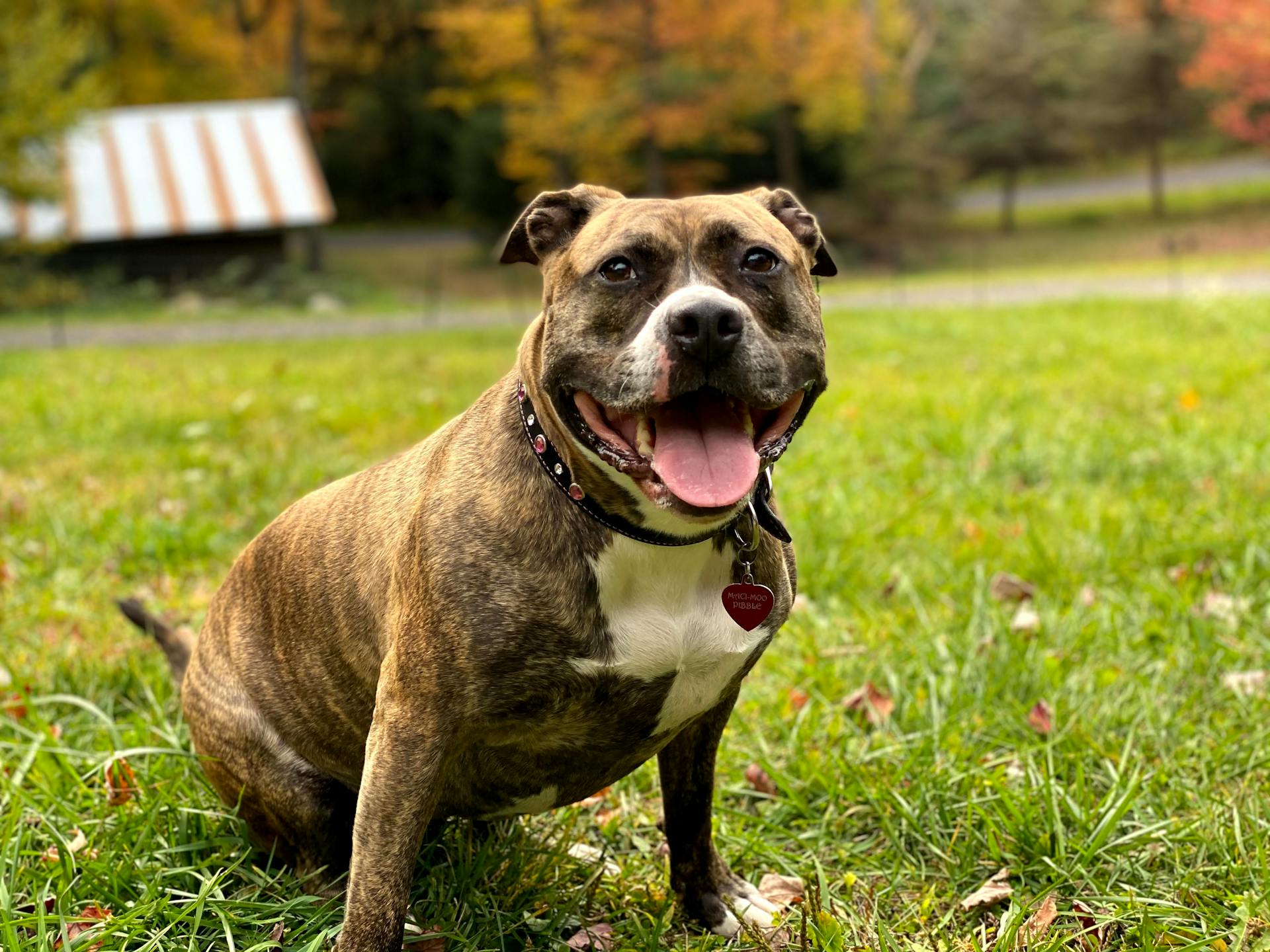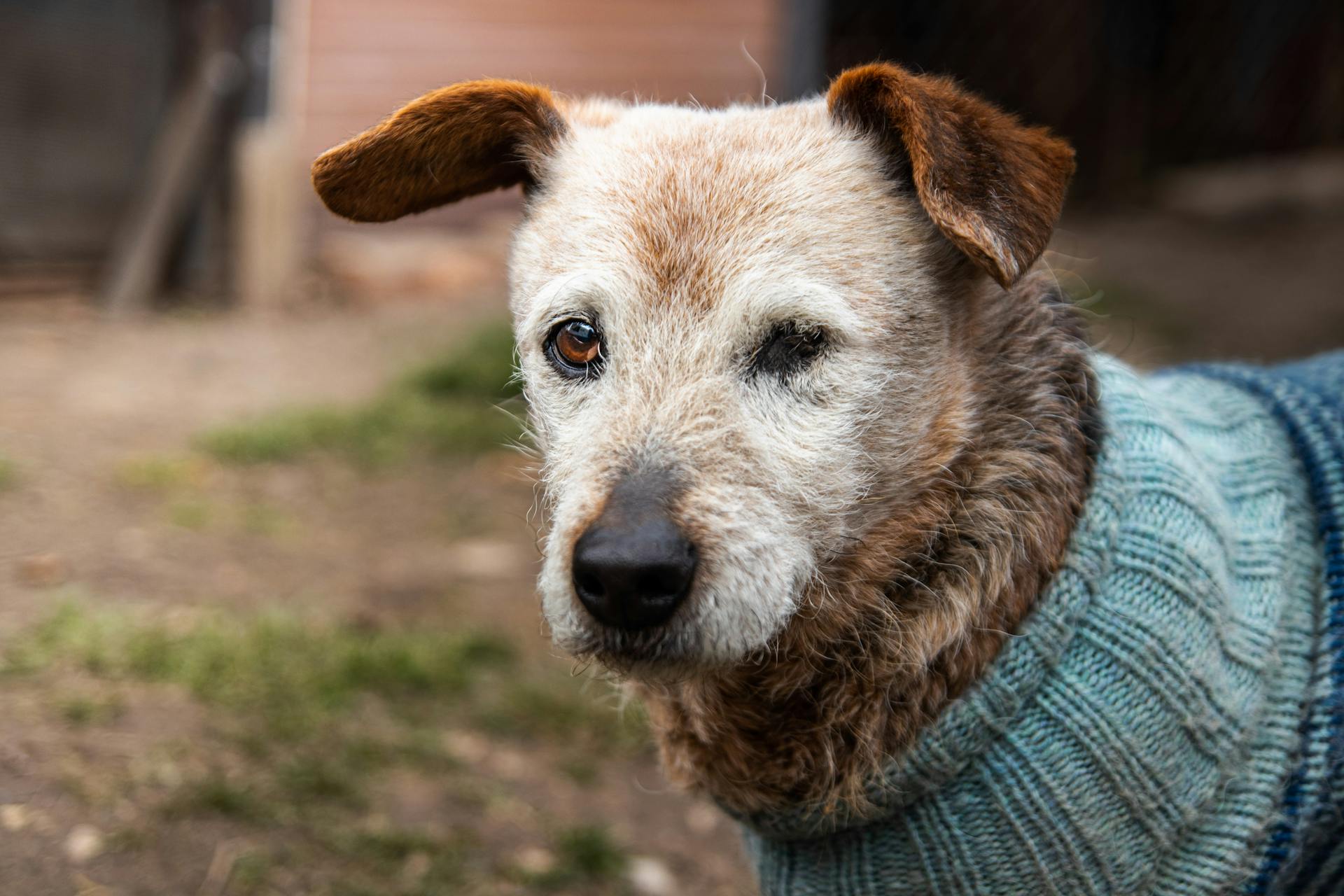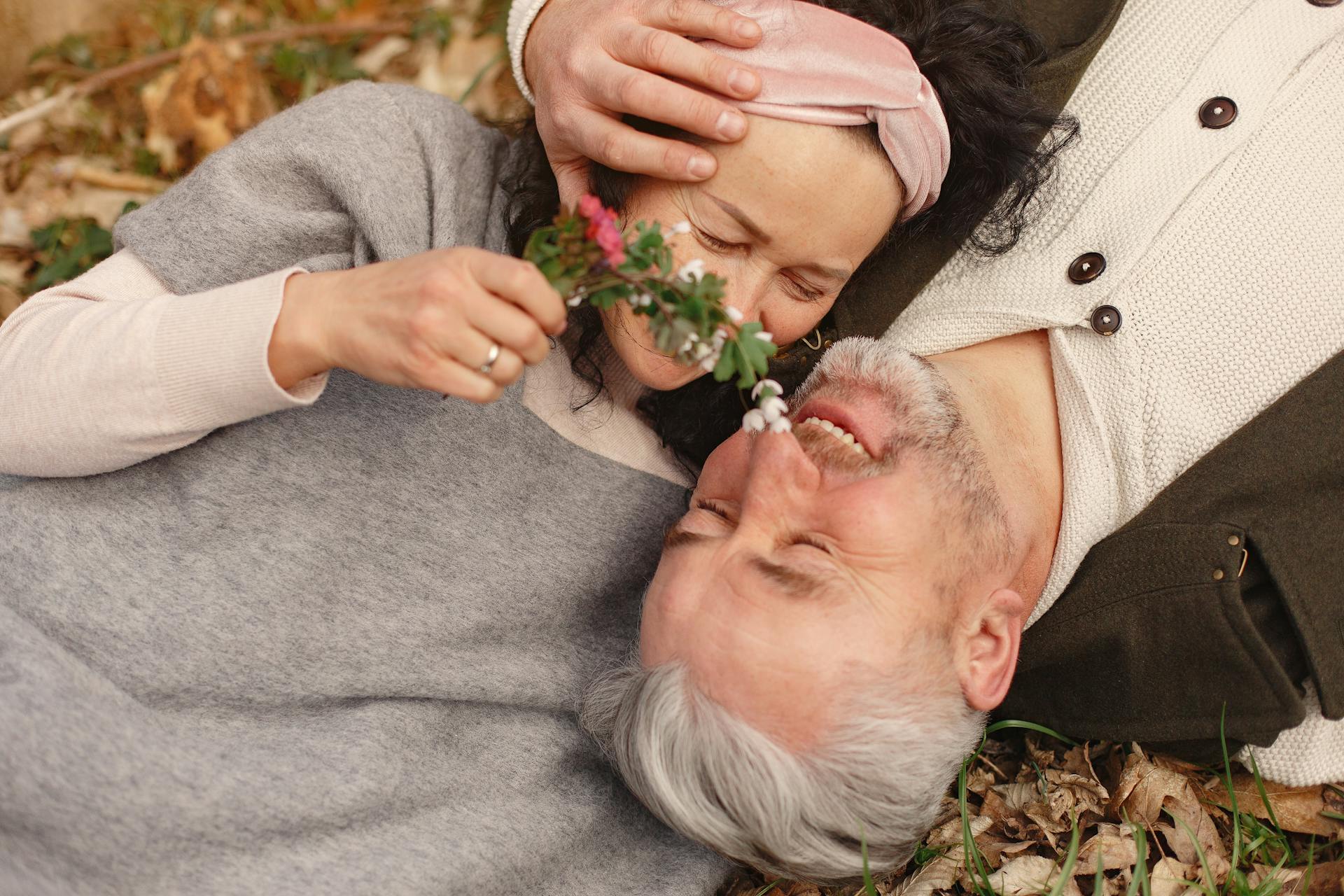
As your Staffordshire Bull Terrier ages, you may start to notice some changes in their behavior and physical appearance. One of the first signs of old age in Staffies is a decline in their energy levels, typically around 7-10 years of age.
Their joints may start to creak and groan due to degenerative joint disease, which can be a result of their compact body and short legs. This can cause them to move more slowly and stiffly.
Staffies are prone to obesity, which can exacerbate joint issues and lead to other health problems. Keep an eye on their food intake and ensure they're getting regular exercise to maintain a healthy weight.
It's essential to monitor their dental health, as Staffies are prone to dental issues, including tooth loss and gum disease. Regular brushing and check-ups with your vet can help prevent these problems.
For more insights, see: Homemade Dog Dental Treats
Staffy Health Issues to Watch Out For
Staffordshire Bull Terriers can be prone to certain health issues as they age, and it's essential to be aware of the signs to catch any potential problems early.
Arthritis is a common issue in Staffies, causing joint pain and stiffness.
Cushing's disease, also known as Hypoadrenocorticism, can lead to weight gain, thinning fur, and excessive drinking.
Cancer is another serious health issue that can affect Staffies, and it's crucial to monitor for any changes in appetite, weight, or overall health.
Heart disease can also be a concern, with symptoms including coughing, difficulty breathing, and lethargy.
If you notice any of these signs, contact your local vet immediately.
Here are some key areas to assess your Staffy's health:
- Affection and engagement
- Eating and drinking
- Sleeping
- Toilet troubles
- Suffering from pain
- Movement and getting around
- Mind and body
- How you feel about it
- Any other factors
Be aware of the following abnormal symptoms that could indicate serious disease:
- Change in appetite or water consumption
- Tartar build-up, bad breath, red gums, or broken teeth
- Itchy skin (scratching, chewing or licking), hair loss
- Lethargy, mental dullness, or excessive sleeping
- Fearfulness, aggression, or other behavioral changes
If you notice any of these signs, give your vet a call for an appointment.
Nutrition and Diet
As your Staffordshire Bull Terrier ages, their nutritional needs may change. Proper nutrition plays a vital role in maintaining their health and vitality.
Obesity is a key consideration for senior Bull Terriers, and it's essential to monitor their food intake to prevent weight gain. Many aging Bull Terriers can continue to thrive on their regular adult food.
Inappetence, or loss of appetite, is another concern for seniors. This can be a sign of underlying health issues that need to be addressed.
Specialized diets formulated for seniors can provide the necessary nutrients for optimal health. However, many aging Bull Terriers can still do well on their regular adult food.
Managing Senior Staffy Care
As your Staffy ages, it's essential to adjust their diet and exercise routine to ensure they remain active and healthy. Regular exercise helps maintain muscle tone and strength, while mental stimulation keeps their minds sharp and wards off cognitive decline.
Senior Staffies still benefit from physical activity, but it's crucial to tailor exercise routines to suit their age and physical abilities. Slow strolls, low-impact activities like swimming, and age-appropriate canine calisthenics can all contribute to keeping senior Staffies active and healthy.
To maintain their overall health, it's vital to monitor their appetite and address any issues promptly. Inappetence in senior Staffies can be caused by age-related diseases or conditions, and introducing more palatable foods or appetite-increasing medications can help address these issues.
Here's a list of essential care tasks to keep your senior Staffy happy and healthy:
- Supervise your pet as you would a toddler.
- Brush their coat at least weekly.
- Clean their ears weekly.
- Keep their diet consistent and don't give them people food.
- Exercise them regularly, but don't overdo it at first.
Arthritis
Arthritis is a common issue that can affect Staffies as they age. Their active lifestyle can lead to joint problems, resulting in arthritis.
Stiffness in the elbows or hips is one of the key signs to look out for. This can be a subtle change, but it's essential to catch it early.
Difficulty getting up from lying down is another indication that your Staffy may be developing arthritis. You may notice them struggling to rise or taking longer to get up.
If you notice any of these signs, it's crucial to contact your local vet immediately. Early detection and treatment can make a significant difference in your Staffy's quality of life.
Here are some signs of arthritis to watch out for:
- Stiffness in the elbows or hips
- Lameness
- Difficulty in getting up from lying down
Laryngeal Paralysis
Laryngeal paralysis can be a serious issue for older Bull Terriers, so it's essential to be aware of the signs. Noisy breathing, especially when exercising or in hot, humid weather, is a common symptom.
Older Bull Terriers may develop laryngeal paralysis, where the vocal cords become paralyzed and hang down into the airway. This can lead to severe cases where a pet can collapse and have difficulty breathing.
In mild cases, changes at home and possibly medication can help manage the problem. However, if you notice signs of laryngeal paralysis, bring your pet in right away to avoid a surgical emergency.
Inappetance in Senior Bull Terriers
As your Staffy ages, you may notice a decrease in its interest in food, a condition known as inappetance. This is a normal process, but it can also be caused by age-related diseases or conditions.
Inappetance can be a sign of underlying health issues, such as obesity, which is a key consideration when it comes to senior dog nutrition. Obesity can lead to a range of health problems, including diabetes, arthritis, and heart disease.
If your senior Staffy is experiencing inappetance, there are steps you can take to encourage it to eat. Introducing more palatable foods can be a good starting point, as can appetite-increasing medications or prescription diets.
Here are some factors to consider when assessing your Staffy's quality of life and deciding what to do if it's experiencing inappetance:
- Affection and engagement
- Eating and drinking
- Sleeping
- Toilet troubles
- Suffering from pain
- Movement and getting around
- Mind and body
- How you feel about it
- Any other factors
Recognizing and Managing Diseases
As a Staffy owner, it's essential to be aware of the common diseases that can affect your furry friend. Arthritis, Cushing's disease, cancer, and heart disease are just a few of the serious conditions that can impact your Staffy's quality of life.
Early identification and treatment are critical to ensure the best possible outcome for your dog. If you notice any of the signs mentioned in the article, such as changes in appetite or water consumption, tartar build-up, or itchy skin, seek veterinary help immediately.
In fact, many diseases cause a characteristic combination of symptoms that can be a clear signal that your Bull Terrier needs help. Some common signs to watch out for include lethargy, mental dullness, or excessive sleeping, as well as fearfulness, aggression, or other behavioral changes.
Regular veterinary check-ups are essential, especially during the senior years, as they provide an opportunity to catch and manage age-related illnesses early on. Proper pain management can greatly improve a senior Bull Terrier's quality of life and ensure their comfort and well-being.
You might like: Papillon Dog Diseases
Here are some areas to consider when assessing your Staffy's health:
- Affection and engagement
- Eating and drinking
- Sleeping
- Toilet troubles
- Suffering from pain
- Movement and getting around
- Mind and body
- How you feel about it
- Any other factors
By being vigilant and watching for subtle changes in behavior, you can help ensure your Staffy receives the best possible care and lives a happy, healthy life.
Exercise and Stimulation
As your Staffy ages, it's essential to tailor exercise routines to suit their needs. Senior Staffies benefit from regular physical activity to maintain muscle tone and strength.
Physical activities like slow strolls and low-impact exercises like swimming are great options. They can also enjoy age-appropriate canine calisthenics to stay active.
Mental stimulation is just as crucial as physical activity. It keeps their minds sharp and prevents cognitive decline. Engage their minds with sniff walks, puzzle toys, and trick training.
Providing mental enrichment can prevent boredom and keep your Staffy happy and healthy.
Suggestion: Dog Mental Health Therapy
Importance of Comfortable Rest
As Staffy owners, we want to ensure our beloved companions get the best possible care, especially as they age. Restful sleep is vital for senior Staffys.
Hard surfaces can be unforgiving to aging joints, so investing in a high-quality dog bed can make a big difference.
Orthopedic beds provide extra support for joints and help alleviate stiffness and aches.
Senior Staffordshire Bull Terrier Care

As your Staffordshire Bull Terrier ages, you may notice a decrease in their interest in food, which is a normal process. This decrease in caloric requirements is a natural part of aging.
Inappetence in senior dogs can be caused by age-related diseases or conditions, so it's essential to monitor their health closely. Introducing more palatable foods or appetite-increasing medications can help address these issues.
Regular grooming is crucial for senior Staffordshire Bull Terriers to maintain their coat and overall hygiene. Regular brushing can help prevent matting, especially in areas they may have trouble reaching.
Nail trims should be performed more frequently, as senior dogs tend to be less active, resulting in slower nail wear. This can help prevent painful nail problems.
Grooming sessions also provide an opportunity to examine your senior Staffordshire Bull Terrier for any lumps, bumps, or skin changes that may require veterinary attention. This can help strengthen the bond between you and your furry companion.
For another approach, see: Silky Terrier Grooming
Frequently Asked Questions
What is the most common cause of death in Staffordshire Bull Terriers?
Staffordshire Bull Terriers are prone to heart disease, which is a leading cause of death in this breed, often manifesting as breathing difficulties and weight loss. Regular veterinary check-ups can help identify heart disease early on, ensuring prompt treatment and a better quality of life.
Sources
- https://cloud9vets.co.uk/staffy-health-issues/
- https://iheartdogs.com/know-the-signs-5-most-common-health-issues-in-staffordshire-bull-terriers/
- https://www.petethevet.com/oscar-is-a-twelve-year-old-staffordshire-bull-terrier/
- https://bullterrier.world/blogs/all/senior-bull-terrier-care
- https://myfamilyvet.com/client-resources/breed-info/bull-terrier-white/
Featured Images: pexels.com


